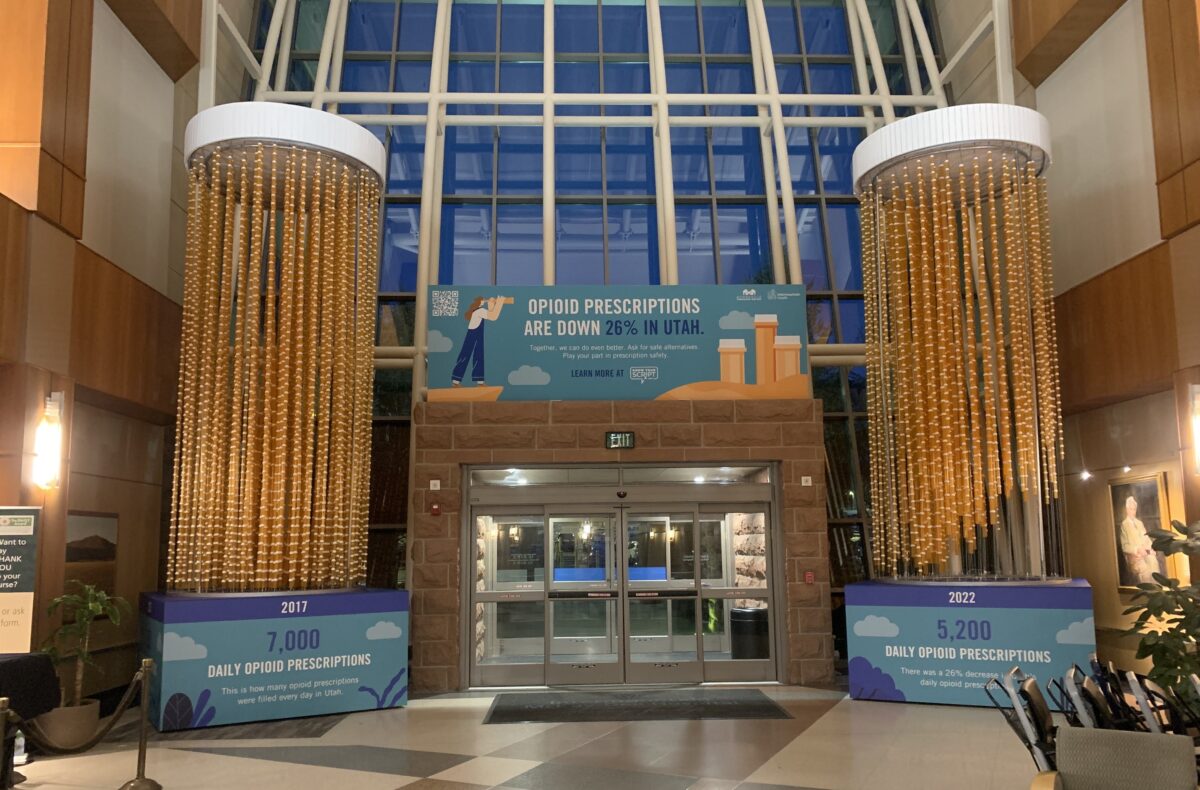McKay-Dee display demonstrates success in curtailing opioid prescriptions
- These two empty pill bottle chandeliers, unveiled Tuesday, Dec. 12, 2023, at Intermountain McKay-Dee Hospital in Ogden, represent the daily number of prescriptions written for opioid medications in Utah in 2017 and 2022. Over those five years, there has been a 26% reduction in the number of pain pills prescribed.
- McKay-Dee Hospital held a press conference announcing its initiative to reduce opioid abuse and increase awareness of risks for opioid users in Ogden on Wednesday, Aug. 31, 2016. Posters and a chandelier made out of 7,000 pill bottles decorates the lobby. According to the hospital, Utahns fill 7,000 opioid prescriptions a day.
OGDEN — When you hear the word chandelier, you probably wouldn’t picture over 12,000 empty pill bottles hanging from the ceiling.
But at Intermountain McKay-Dee Hospital, that’s exactly what you’ll see when you walk through the doors of the main lobby.
The empty pill bottles represent the number of opioids prescribed to patients in Utah over the past six years, but the news was good. On one side of the lobby, a chandelier with 7,000 empty pill bottles represents the number of prescriptions written daily in 2017. On the other side of the lobby, another chandelier represents the 5,200 daily prescriptions written for the pain pills in 2022 — a figure cut by one-fourth in a span of five years.
The 20-foot chandeliers were unveiled by Intermountain Health, Know Your Script and Bonneville Communities that Care during a news conference at the hospital on Tuesday.
“In (2016), we unveiled a large pill bottle chandelier here in our lobby, where each of the 7,000 daily prescriptions was represented by a pill bottle,” said Judy Williamson, president and CEO of Intermountain McKay-Dee Hospital. “However, today’s installation has been somewhat scaled down to represent the 26% reduction in the past five years.”
Williamson said Intermountain makes it a priority to promote awareness, to educate and discuss chronic pain with its patients in order to help them live a functional and high-quality life.
“This display represents all the hard work by our caregivers, physicians and patients as well as the many lives saved through this work,” she said.
According to a recent Utah Health status update from the Utah Department of Health & Human Services, of the 541 drug overdose deaths in Utah in 2022, 74% involved an opioid. Fatal drug overdoses have remained fairly stable in recent years, but health officials said they hope to continue to see that number decrease as well.
“I think every home safety kit should have Naloxone in it,” said Kim Compagni, assistant vice president for pain management at Intermountain Health.
Naloxone is a rescue medication used to treat overdoses in emergency situations.
“Naloxone saves lives, not only in adults, but in children and pets as well,” Compagni said. “Opioids have risks so we need to continue to come up with alternative solutions for pain control for our patients, including mindfulness, physical therapy, massage, ice, heat, acupuncture and medical nutrition counseling.”
Compagni said in Utah alone, about 1 in 5 adults (21%) are affected by chronic pain.
“These changes are huge wins for improving patient safety and keeping patients safe from potential addiction, misuse or even unintentional overdose,” she said.
Ogden resident and former United Way of Northern Utah CEO Robert Hunter said his wife, Rula, was one of the first people in Utah to be given Oxycontin in 1996. She immediately became addicted.
“After two years in recovery and two years in aftercare, she and I became volunteers for addiction recovery services,” Hunter said. “Vulnerability, openness and displays like this will help mitigate the stigma often attached to addiction. There shouldn’t be a stigma. We need to talk about it and be aware of it and address it head on. Together, I hope we can all help heal one another.”
Dr. Michelle Hofmann, deputy director at HHS, said that while the reduction in written opioid prescriptions is something to celebrate, there is still work to be done.
“Between 2018 and 2023, there has been a 500% increase in fentanyl overdose deaths,” she said. “We need to continue to do more to screen for addiction and eliminate the stigma. Our department is committed to prevention efforts and will continue to work to reduce opioid prescription misuse in Utah.”
South Ogden Mayor Russell Porter said localized efforts have played a crucial role in the reductions being celebrated today.
“By addressing community-specific needs and leveraging resources available at the community level, we not only prevent opioid prescription misuse but also ensure the well-being of our residents, exemplifying the power of local coalitions in creating positive and enduring impact,” Porter said.




